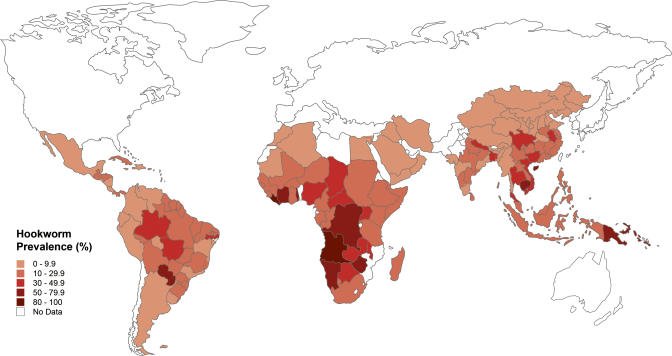
Now, let’s delve a little deeper into the fascinating world of hookworms. Understanding where they thrive isn’t just an academic exercise; it’s essential for developing effective control and prevention strategies. Here’s the thing: if we comprehend their range and distribution, we can take better steps towards combating these unwelcome guests. So, grab your favorite drink, and let’s explore the documented range and distribution of hookworms around the globe.
What Are Hookworms?
Before we dive into their distribution, let’s take a moment to understand what hookworms actually are. Hookworms are parasitic roundworms typically found in warm climates. There are a couple of common species, with *Ancylostoma duodenale* and *Necator americanus* being the most notorious among them. You might find it intriguing that these worms attach to the intestinal walls of their hosts with special mouthparts, which resemble hooks—hence the name “hookworm.”
These critters can cause a range of health issues, primarily anemia and protein deficiency, as they feed on your blood. This makes them particularly dangerous for vulnerable populations, like children and pregnant women, who might already be battling nutrition deficits. Honestly, the fact that something so small can have such a big impact is both fascinating and alarming.
The Global Distribution of Hookworms
When we look at their distribution, it’s essential to realize that hookworms primarily thrive in certain geographical areas. Most commonly, they are found in tropical and subtropical regions, particularly in parts of Africa, Asia, and Latin America. These areas usually have warm, moist climates that provide ideal conditions for hookworms to develop and survive. If you picture a map, you’d see clusters of reports and cases in these warm climates.
In Africa, countries like Nigeria and Tanzania report high incidences of hookworm infections. Meanwhile, in Southeast Asia, nations such as Vietnam and India are significantly affected. Surprisingly, the problem isn’t limited to developing countries; some areas in the southern U.S. also see cases, highlighting that hookworms are adaptable creatures.
How Hookworms Spread
You might be wondering how hookworms make their way into the human body. The lifecycle of hookworms is both clever and unfortunate for us. It begins when larvae present in contaminated soil penetrate human skin—often through the feet. If you’ve ever walked barefoot in a tropical region, you might understand the risk!
Once they enter the body, these little invaders travel to the lungs and eventually to the intestines, where they mature into adults. From there, they start laying eggs, which are expelled through the host’s feces, continuing the cycle. It’s a bit like a well-organized relay race, except the baton is a nasty parasite, and the stakes are our health.
Risk Factors for Hookworm Infections
Understanding where hookworms live leads us to the various risk factors associated with infections. A few key factors include:
- Poverty: Many affected areas have limited access to clean water and sanitation facilities, leading to higher infection rates.
- Geography: Regions with tropical and subtropical climates create a hospitable environment for hookworms to thrive.
- Footwear: Walking barefoot in contaminated areas increases the likelihood of larvae penetrating the skin.
- Education and Awareness: Lack of knowledge about transmission routes can lead to higher vulnerability.
These risk factors play a huge role in why certain populations are more affected than others. It’s not just a matter of having these worms around; it’s about the conditions that allow them to flourish.
Impact on Public Health
The implications of hookworm infections on public health are significant. They contribute to a cycle of poverty and malnutrition, particularly in areas where healthcare resources are scarce. For instance, chronic hookworm infections can cause anemia, which affects energy levels and overall health, making it difficult for individuals to work or participate in school.
In children, this can impact growth and cognitive development, potentially leading to lifelong consequences. The economic burden on communities where hookworms are prevalent can be staggering, as infected individuals may miss work or school, affecting productivity and education.
Control and Prevention Strategies
So, what can be done to combat this persistent problem? A mix of strategies is essential for effective control and prevention of hookworm infections. Here are a few key approaches:
- Improving Sanitation: Ensuring access to proper sanitation facilities can help stop the cycle of infection.
- Regular Deworming: Mass deworming programs in affected areas can significantly reduce the burden of infection.
- Education and Awareness: Informing communities about risks and preventative measures, such as wearing shoes and proper hygiene, can help.
- Environmental Management: Reducing the presence of contaminated soil and improving drainage can limit larvae spread.
Taking these steps not only helps to control hookworm populations but also promotes healthier communities.
The documented range and distribution of hookworms highlight the importance of understanding these parasites and their impact on public health. With millions of people affected worldwide, it’s crucial to address the risk factors and implement effective prevention strategies. By improving sanitation, educating communities, and conducting regular health measures, we can significantly reduce the burden of hookworm infections.
Let me be clear: combating hookworms isn’t just about the worms themselves; it’s about lifting communities out of poverty and preventing the cycle of infection that keeps them tethered. Understanding where and how they thrive is just the first step toward a healthier future. Together, we have the tools to make a difference!
